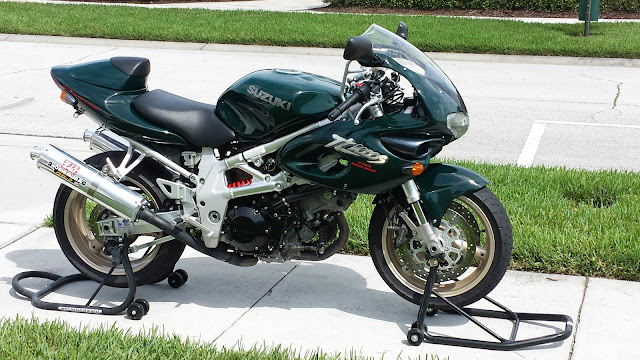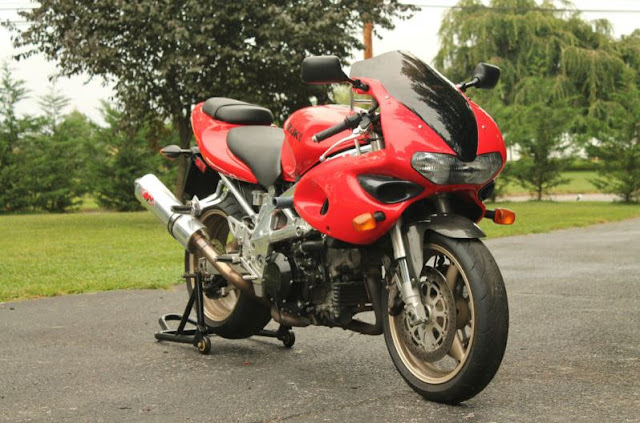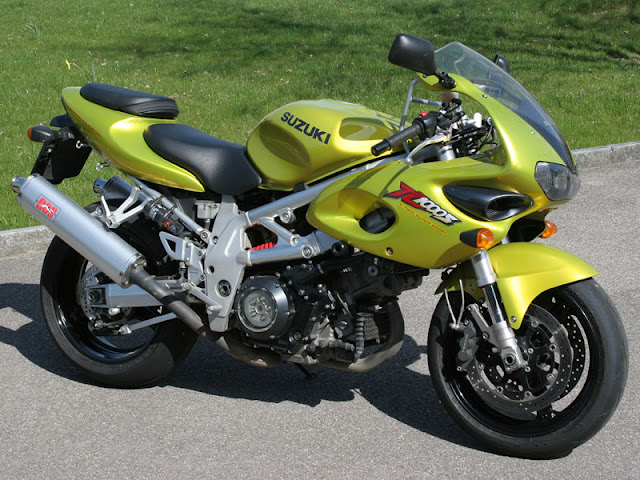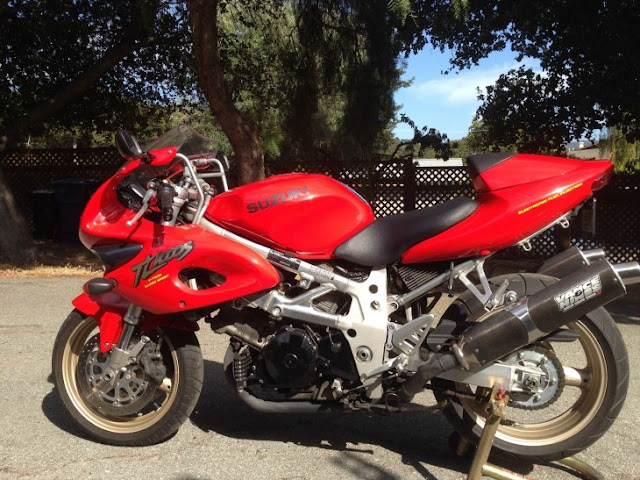Suzuki TL1000S
Suzuki’s launch of the TL1000S seemed to herald a new era of V-twin Japanese super-sports bikes. The TL's powerful 996cc, eight-valve engine was held in a light and technically innovative chassis; and the half-faired Suzuki was stylish, aggressive and competitively priced. This was the bike that proved the Japaneseeould build exciting V-twins, and which promised to give Ducati some serious competition.
Unfortunately for Suzuki, that was not how things worked out. The TL1000S was introduced to near universal praise, for its stunningly powerful and torquey engine and also for its handling and high level of technology. But that agility occasionally turned into instability. Rumours of severe wobbles (‘tank-slappers') caused the TL to be recalled for fitment of a steering damper. Its sales never recovered.
In reality the scare stories (which appeared in only a few countries) were often exaggerated, and the TL1000S was in almost every respect an outstanding superbike. Its engine was a liquid- cooled. dohc 90-degree V-twin. A ram-air system fed a Mikuni-Denso fuel-injection set-up. giving a maximum output of I23bhp at 8500rpm - more than both Ducati's 916 and also Honda’s VTR1000F, the less charismatic rival Japanese V-twin that was launched at the same time.
The frame was a tubular aluminium construction that incorporated a unique rear suspension system consisting of a single spring (placed near-horizontally on the right) and separate rotary damper. This compact arrangement allowed the engine to be placed further back, giving a short wheelbase for extra manoeuvrability. Other cycle parts were conventional and of high quality, notably the multi-adjustable, upside-down Kayaba forks, and the front brake combination of 320mm discs and four-piston Nissin calipers.
The motor was a real star, with all the performance and character of a good V-twin. The TL pulled crisply at low revs and was wonderfully strong through the mid-range, giving enough instant acceleration to lift the front wheel with a gentle twist of the throttle. And the free-revving engine really took off at 6500rpm, sending the tacho needle shooting round to the I0.500rpm redline. and hurling the Suzuki forward towards a top speed of I60mph (257km/h).
Handling was good in most situations, though the TL was rather fussy about suspension set-up, and few experts were convinced about the benefits of the rotary shock damper. The Suzuki was light at 4l2lb (187kg). and its steering angle was steep. This contributed to effortless steering response and rapid direction changes, as w ell as the twitchiness that earned the TL its bad reputation.
With its handling calmed by a steering damper (preferably of higher quality than the cheap item that was belatedly specified by Suzuki) there was very little wrong with the bad-bo\ Y-tw in. and a great deal that was right. It was fast, light, flexible, reasonably comfortable, and bursting with Y-tw in character. Perhaps more than an\thing, the TL1000S got its rider's adrenaline flow ing like few other bikes on the road.
Racy Relation: the TL1000R
Suzuki waited only a year before following-up the TL1000S with a fully-faired, beam-framed derivative, the TL1000R. This was designed as the basis of the firm's challenge in World Superbikes, where the rules traditionally favoured twins over fours. The 134bhp TL1000R was more powerful, smoother and more controllable than the S model. But it lacked some of the storming mid-range power that made the half-faired bike so much fun, and was also bulkier and heavier. That would not have mattered if the TL-R had been a winner on the track, but it was uncompetitive in US racing and did not displace the GSX-R750 four as Suzuki's choice in World Superbikes.
When parked it looked innocent, but the TL \ bad-boy reputation hit sales and ultimately ended its production in 2001.
As well as Suzuki’s first super-sports V-twin engine, the TL featured a tubular aluminium frame whose rear shock had an innovative rotary damping unit.
Specification Suzuki TL1000S (1997)
- Engine Liquid-cooled dohc eight-valve 90-degree V-twin
- Capacity 996cc (98 x 66mm)
- Maximum power 123bhp @ 8500rpm
- Transmission Six-speed, chain final drive
- Frame Tubular aluminium
- Suspension Telescopic front; monoshock rear
- Brakes Twin discs front; disc rear
- Weight 4121b (187kg)
- Top speed 160mph (257km/h)





















0 comments: